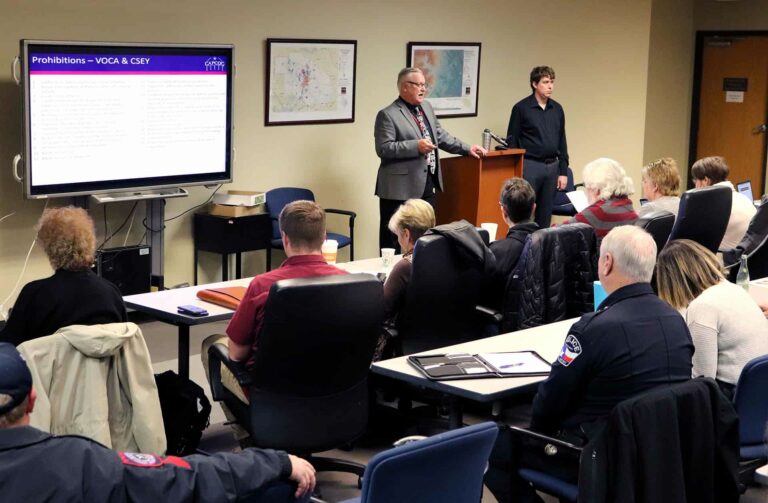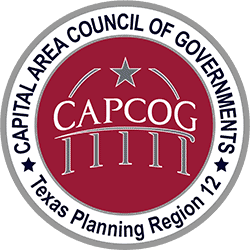Home » Divisions » Regional Planning & Services » Criminal Justice
Criminal Justice
CAPCOG’s Criminal Justice Program is designated by the Office of the Governor’s Criminal Justice Division (CJD) for regional coordination efforts on the subject in the 10-county CAPCOG region.
Each year the programs helps develop a Regional Strategic Criminal Justice Plan by conducting a review and providing updates to previous year plans. It organizes several community stakeholder meetings and works with the CAPCOG Criminal Justice Committee, of which it provides staff support, to garner input and direction for the plan. The plan identifies gaps in direct victim assistance, juvenile justice, mental health, substance abuse, and criminal justice issues, so services, existing programs, new initiatives, and funding opportunities may be reviewed and resources targeted accordingly.

Criminal Justice Grants
The program also facilitates the grant application scoring process for four CJD grants — General Victim Assistance Direct Service Program; Violence Against Women Justice and Training Program; Juvenile Justice and Truancy Prevention Grant Program; and Criminal Justice Program.
Using information compiled during community stakeholders’ meetings, through surveying and work with the committee, it develops the grants’ funding priorities that assists the committee in ranking grant application. The program also provides technical assistance to applicants for CJD grant funding opportunities to include criminal justice, juvenile justice and victim services-related programming.
Criminal Justice Resources
The following data is compiled from the Texas Department of Public Safety’s Crime in Texas Report. The state report makes use of Uniform Crime Reporting, which has an objective to generate reliable crime statistics for use in law enforcement administration, operation, and management as a means to make it possible to analyze crime trends primarily through the Crime Index. Definitions of the terms and crimes used in the compiled data can be found on the state’s public safety website, dps.texas.gov.
Crime Statistics and Information in CAPCOG
The tables and maps below provide information on seven index crimes included in the Uniform Crime Report, a FBI report on data collected from law enforcement agencies in the United States. Useful definitions include:
- per 100,000 residents: The number of reported incidents, divided by a jurisdictions population, and multiplied by 100,000.
- Arrest Rate: The number of arrests, divided by the number of reported incidents, and multiplied by 100.
- Clearance Rate: The number of incidents cleared, divided by the number of reported incidents, and multiplied by 100.
- Cleared: Crimes are cleared by arrest or exceptional means, if making an arrest is beyond the control of an agency.
This data was collected and displayed by CAPCOG under contract with the Office of the Governor, Criminal Justice Division using data from the Texas Department of Public Safety’s Crime in Texas Reports from 2008 to 2016.
Evidence-based Resources
Below are organizations that local communities can use to help identify solutions to problems and to see how the implementation of those solutions impacted other communities. CJD is interested in funding projects whose potential for success are backed up by evidence. These resources can provide this evidence.
Justice Assistance Grant (JAG) Program
CrimeSolutions.gov is a clearinghouse website that provides resources for researching evidence-based practices. It is maintained by the U.S. Department of Justice. Criminal Justice Advisory Committees and applicants are encouraged to review CrimeSolutions.gov and other resources to prioritize the funding of projects that have been shown to be effective.
Juvenile Justice and Delinquency Prevention-Local Services
The U.S. Office of Juvenile Justice and Delinquency Prevention maintains a Model Programs Guide (with information about evidence-based juvenile justice and youth prevention, intervention, and reentry programs. It is a resource for practitioners and communities about what works, what is promising, and what does not work in juvenile justice, delinquency prevention, and child protection and safety.
Another resource is the Juvenile Justice Information Exchange, a project of the National Juvenile Justice Network, the MacArthur Foundation, and the Juvenile Justice Information Exchange – a comprehensive source of information on cutting-edge juvenile justice issues and reform trends.
General Victim Assistance Direct Services Program (Victims of Crime Act – VOCA)
OVC TTAC is the gateway to current training and technical assistance for victim service providers and allied professionals who serve crime victims. It maintains several online resources. The Training and Technical Assistance Center has online trainings (Victim Assistance Training-Online), webinars, a directory of consultants, and offers limited in-person training upon request.
- The resource library is a searchable collection of materials that can be used for organizational development and training needs. Inside are tools, promotional items, reference materials, and more.
- OVC offers an array of resources to help build capacity to improve services and outcomes for victims of crime. Materials on this website address a full spectrum of issues that impact victims and the people who provide assistance and services to them. The resources are available in a variety of formats and delivery methods.
- OVC HELP for Victim Service Providers Web Forum: “a place where victim service providers and allied professionals can connect to peers, share ideas about best practices, and help change lives.” You can also contact OVC directly with questions via online contact form or phone: 1-800-851-3420 or 202-836-6998 (TTY 301-240-6310).
- SANE-SART offers online and on-site learning for victim advocates, members of law enforcement, prosecutors and crime lab specialists. These learners practice and gain experience at investigating sexual assault crimes, assisting victims and prosecuting offenders.
- Justice Solutions is a web site by crime victim professionals for crime victim professionals. It has online guides, articles, and other resources.
- CrimeVictims.gov is a federal website with links to victim services resources.
- The National Center for Victims of Crime maintains a resource directory for service providers working with crime victims with disabilities.
- The National Center for Victims of Crime maintains a library of publications on best practices.
- The National Criminal Justice Reference Service is a federal government website with information on many topics, including victim services.
Violence Against Women Justice and Training Program (Violence Against Women Act – VAWA)
Please refer to the other Evidence-Based Practices resources listed on this page, as many contain information pertinent to the program areas funded under VAWA. Resources more specifically covering violence against women are listed here:
- End Violence Against Women International’s (EVAWI) website contains best-practices resources.
- A 2015 Lancet journal article reviewing the topic, “Prevention of violence against women and girls: what does the evidence say?”
- The Michigan State University Consortium on Gender-based Violence has information on their Evidence-based Advocacy Intervention for Domestic Violence Survivors program.
- California Evidence-Based Clearinghouse for Child Welfare
- The Center for Disease Control and Prevention operates a website on Sexual Violence: Prevention Strategies.
- The Domestic Violence Evidence Project
- The Department of Justice’s Legal Aid Advocacy Roundtable Toolkit
Other Resources
CAPCOG has compiled a list of sample applications[BROKEN] from projects that received funding from previous years’ grant process. While contained in a .pdf file format, the text and documentation of these applications are shown as they appear in egrants.gov.texas.gov.
